
Manaus is the capital of Amazonas State of Brazil, with the Amazon basin covering over two million square miles, over one third of the area of the country. Manaus is situated in the heart of the Brazilian rainforest 900 miles inland from the Atlantic coast. The area is covered almost entirely with tropical rain forest of great variety, which is known as ‘inferno verde’ or ‘green hell’ with only a rainy season as it lies just below the equator and has an average hot temperature of 25 degrees Centigrade and a daily variation of only 2.6 degrees Centigrade. The mighty Amazon is of length 4,080 miles and is the second longest river in the world, collecting the flood water of the high Andes from Bolivia to Colombia, and is fed by the tributaries of the Rio Negro, the Madeira and the Xingu rivers. It is navigable past Manaus to Iquitos, at 1,200 miles from the sea, and into Eastern Peru, but the tributaries are blocked by massive rapids and falls. The early explorers were hard pressed to hack and cut their way through the dense forest with machetes, with the always permanent presence and threat of large spiders, tarantulas and snakes, some venomous, leading to death either quickly or slowly from cancerous wounds.
When the snows of the high Andes melt and the Amazon rainfall reaches a peak, a great annual flood is swept down the Rio Negro river of up to 40 feet (12 metres) in height, rising to flood level in February and March and beginning to recede in June. The highest river level of 29.97 metres was recorded in the great flood of 2012 at Manaus, with a minimum ebb level of only 13.63 metres on the river recorded in 2010. As a consequence of this dramatic river rise and fall, all waterside properties are built on high stilts, with the Port of Manaus having two floating wharves, detached from the bank and named Paredao and Malcher. The Paredao floating platform has four berths for deep sea vessels on its inside and outside berths, whereas the Malcher floating platform is used only by river passenger craft and fishing boats for most of the year, with a theoretical three further berths for larger ships during the massive flood period.
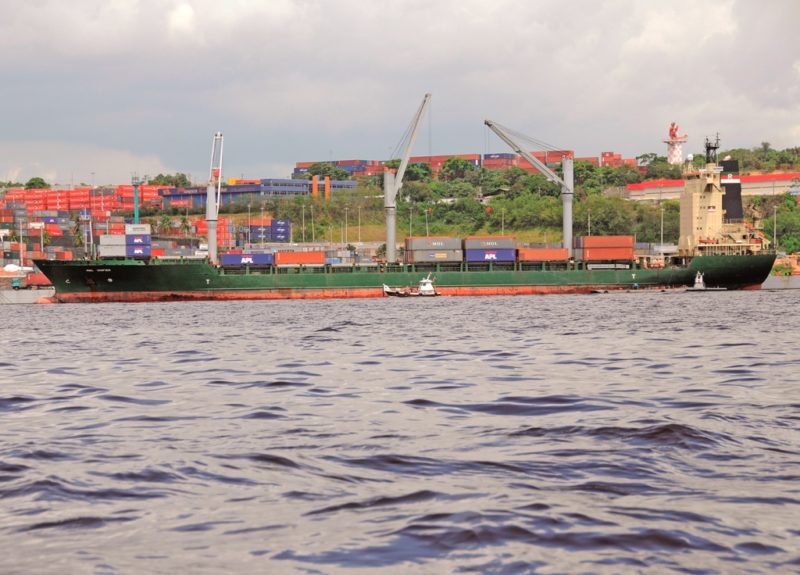
HISTORY OF MANAUS
The first Spanish explorers discovered the wide mouth of the Amazon in 1499, the width being an enormous seventy miles. The Spanish explorer Francisco de Orellano sailed along most of the wide Amazon in 1542, and the first European explorers and settlers built a small fort in 1669 named Sao Jose de Rio Negrinho by Capt. Francisco da Motta Falcao. The fort had four cannons for protection against Portuguese forces based in what today is Surinam, with the fort operational for one hundred years. The mission and village that later grew up was named on 24th October 1848 as Cidade (Villa) de Barra do Rio Negro, ‘barra’ is the name of the river margins and sand bar at the mouth of the Rio Negro. The village lay on the north bank of the Rio Negro, only eleven miles from the junction of the ‘encontro des dos aguas’ (meeting place of the two waters) of the Rio Negro and Solimoes rivers that combine to form the mighty Amazon leading eventually to the sea. The black waters of the Rio Negro form a black diving line with the brown waters of the Solimoes at the junction, and do not mix together for many miles downstream. The town had succeeded Barcelos in 1809 as the capital of the Rio Negro area, and in 1850 became the capital of Amazonas province, later becoming a State of Brazil. The name was then changed to Manaos after an Indian river tribe on 4th September 1856, and since 1939 the name has been spelled Manaus. Manaus is sited at an elevation of only 302 feet above sea level making deep sea ship navigation from the distant South Atlantic very easy.
The town profited from a great regional rubber financial boom from 1880 in the production of natural rubber from the tree ‘Hevea Brasiliensis’ and brought great prosperity to the town. At the height of the boom, Manaus had 88% of the world rubber market. This boom lasted until 1920 as rubber latex was needed for the tyres of the early motor cars, but rubber plant seeds were smuggled to Malaya to end the monopoly of the Amazon. Neoprene and other synthetic rubbers have since dramatically lowered the demand for natural rubber. During the rubber boom, it is estimated that diseases brought by immigrants e.g. typhus and malaria killed 40,000 native Amazonia people. The tapping of rubber trees became unsustainable in the lower Amazon basin, but ‘rubber fever’ continued to grip the owners of rubber trees in areas around Manaus.
The primitive port of Manaus had extensive sandy beaches and extended from the foot of the great waterfall of Sao Raimundo to the Educandos tributary. A precarious sling system with cargo suspended from long wires while moving along the wires to the shore from the discharge cranes at offshore platforms was used in the early 1880s for the loading of rubber latex and the discharge of general cargo from deep sea ships to the shore warehouses. However, in the mid 1890s, the Amazonas Province built a ‘trapiche’ or waterfront warehouse with a ramp and direct exit from the river to the trapiche.
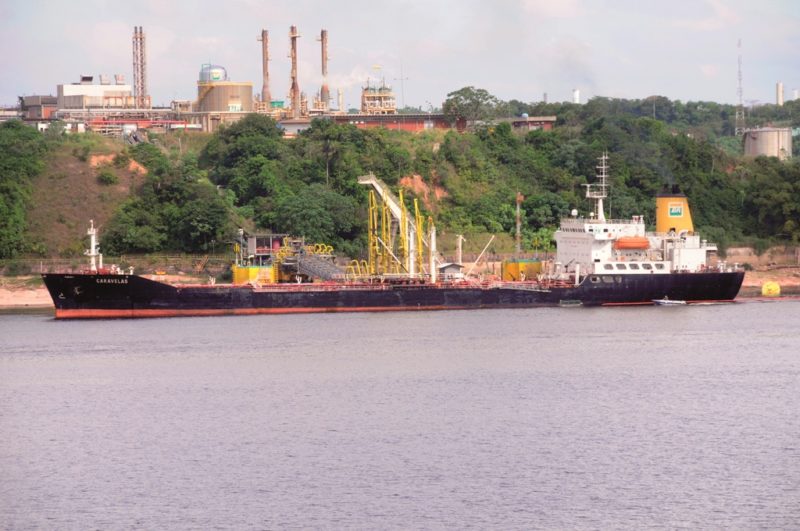
A contract was then signed by the Amazonas Province with the Sao Paulo firm of B. Rymkiewecz and Company, run by a Polish aristocrat, for the construction of a more permanent unloading floating facility with a roadway bridge to the shore warehouses. No progress was made on this construction, and on 5th September 1899 the Federal State Government of Brazil opened a competition for river improvement works at the Port of Manaus. The deadline for the delivery of tenders was extended until April 1900, with the winner of the competition being the same Sao Paulo form of B. Rymkiewecz and Company, which signed the contract on 25th August 1900. No progress was again made by this firm on a start to the construction, and both contracts were then passed on in 1902 to the Manaus Harbour Ltd. of London with a capital of £500,000, jointly owned by the Booth family and their partners of B. Rymkiewecz and Company.
The Booth family were big shipowners in the shape of Alfred Booth (born in 1834) and Charles Booth (born in 1840) and sons of Charles Booth, a corn merchant in the Port of Liverpool. Charles Booth first came to Para at the mouth of the mighty Amazon in 1866 on the deck of his first steamer Augustine, and by the 1880s the Booth family were the leading industrial force at Manaus. The official solemn starting date for the Port of Manaus construction works was 7th October 1902, and the ceremony was attended by Dr. Silverio Nery, Governor of Amazonas State. These works were carried out in various stages:-
The Machine House was built in 1903 and is now the home of the Port Museum as well as Warehouse 7 and a temporary pier.
Warehouses 9 and 10 were built in 1904, the metal tower for the water box, the railway lines for serving the warehouses, the first part of the Roadway Bridge, and the installation of the first electricity generators.
The areas around Warehouses 9 and 10 were paved in 1905, and a retaining wall was built at the base of these two warehouses, and an inclined plane at the front of Warehouse 7.
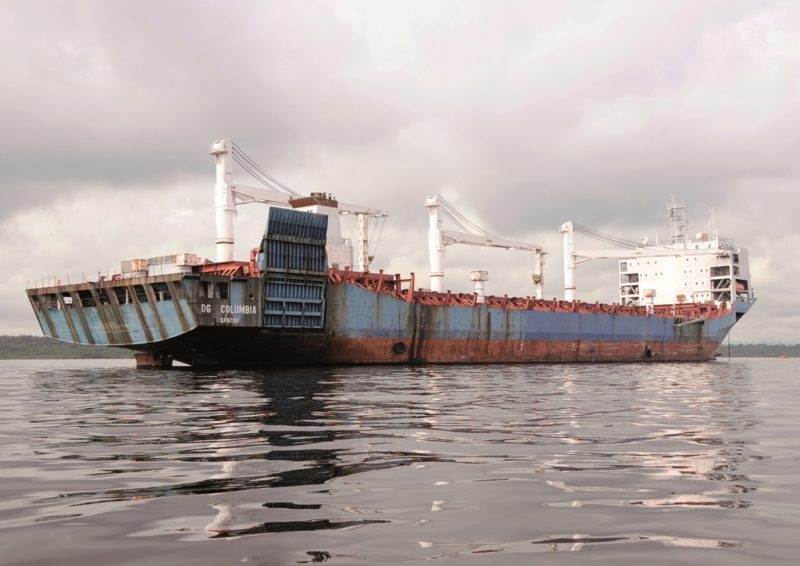
The Customs House (Alfandega) or ‘Guardamoria’ in Portuguese was built in 1906 of Scottish granite stone with English trimmings and decorations, and also the second stretch of the masonry pier as well as the wooden platform and the completion of the Floating Bridge of the Roadway. The Customs House was built in the Portuguese architectural style by British architect Edmund Fisher, and had a tower on the roof to produce a light of great intensity for shipping on the river.
The Port General Office was completed in 1907, but other works dragged on until 1910. The Manaus Harbour Ltd. Head Office was completed in 1907 to a design by H. M. Fletcher and G. PInkerton, and the company general office was on the ground floor with the accommodation for the directors on the first floor.
The Roadway Bridge had pedestrian paths at the side for the easy embarkation and disembarkation of passengers. The bridge was an admirable construction built on a long row of watertight cylinders, and was horizontal to the level of the shore at times of the highest flood, and at ebb times sloped downwards. The roadway in the centre of the bridge was for the fast movement by electrically powered ‘wagonettes’ carrying cargo to the safety of the shore warehouses. Unfortunately, this first roadway bridge was cut in half by a collision caused by the merchant ship Helena in 1978, and was then replaced by a new roadway bridge.
The Waterway Station (Taqueirinha) is a very recent addition to the masonry quays opposite the Paredao floating terminal for river passenger ships and cruise ships. A modern long area contains the modern office of the port, and passenger terminals for buying tickets for the river passenger ships, as well as cafes and lounges while waiting for a river ship to arrive and to look out over a very pleasant vista of river traffic.
The new Port of Manaus began with a cargo throughput of 200,000 tons per year, and in the first and second decades of the 20th century at the height of the rubber boom it reached a trade of one million tons per year. The port was a great meeting place for all of the families of the town, strolling along the masonry quays and viewing the arrival of British steamers, chiefly those of Booth Line. The English operated port company clearly demonstrated its intention to maintain British economic power over the Amazon during the rubber boom era. Manaus was one of the first cities in Brazil to be lit by electricity, and this ‘belle epoque’ of prosperity brought a beautiful cathedral with two high towers on the front facade, an ornate opera house called Teatro Amazonas, constructed after fifteen years and opened in 1896.
The Teatro Amazonas with pink and white exteriors and a vast central dome is one of the last relics of the great rubber boom, and was designed by the Portuguese Engineering Academy in Lisbon with a very grand stage, large orchestra pit and gilded interiors. It had an iron outer structure built at Glasgow on the Clyde and shipped out in sections for reassembly, together with 66,000 coloured bricks to decorate the outer walls and dome imported from France. The frescoes were commissioned from the Italian painter Domenico de Angelis. It was renovated between 1987 and 1990 and today plays to packed audiences. The Teatro was built at a public cost of $10 million but was closed for most of the 20th century, and today it has reopened and contains in addition to the theatre, a museum, Italian frescoes, crystal chandeliers, gilded balconies and wrought iron bannisters.
Marble, crystal and glass was sourced from France for other buildings e.g. the Palacio Rio Negro, a former seat of provincial government, with the city known as the ‘Paris of the Tropics’ during the rubber boom. The Teatro Amazonas, the Palacio Rio Negro and the Law Courts formed a very fine block of new buildings. The rubber barons filled their large villas with every extravagance of the period, and champagne was even given instead of water as a drink for the horses that filled their stables. The tall marble ‘Ports Monument’ in front of the Teatro Amazonas on the Largo de Sao Sebastiao was opened in 1900 to commemorate the liberation and opening of the ports of the Amazon river to foreign trade in 1866.
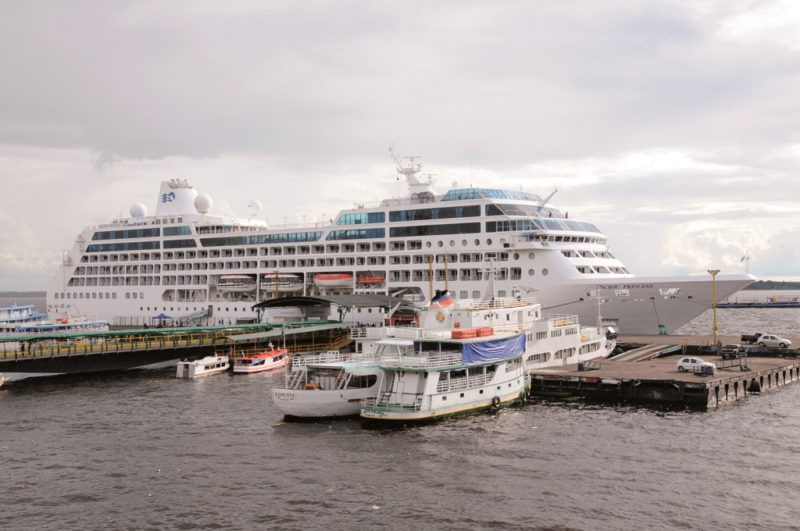
The oldest market in the Port of Manaus is called Mercado Adolpho Lisboa of 1882 and is a copy of Les Halles market in Paris. The Federal University of Amazonas was opened in 1909 and is the oldest Federal university in Brazil and contains a unique very large urban forest, the largest in the world. The Geographical and Historical Institute of Amazonas was founded in 1917, and the National Research Institute of Amazonia was founded in 1954. The Parque de Matriz is a large green area in downtown Manaus near the port.
The Booth Line took over the competing Red Cross Line fleet of Liverpool run by the Singlehurst family in 1901, and its fleet in 1920 was composed of seventeen deep sea steamers, four river steamers of up to 469 grt, fourteen tugs of which the largest were Pelorus of 128 grt built by Scott & Sons of Bowling in 1911 and registered in Manaus, and Conqueror of 112 grt built in 1897 at Falmouth for Swansea owners and arriving on the Amazon in 1900, 133 barges, four old storage hulks for the storage of cargo, one passenger launch, one water boat, and one dredger. The use of river steamers, barges and tugs by Booth dated back to the late 1880s for service on the Amazon, and at one time it had interests in the coastal Brazilian trade from the Amazonas State.
The Booth Line fleet in 1932 comprised thirteen deep sea steamers, of which the largest were the famous passenger liners Hilary of 7,403 grt built in 1931 with a good turn of speed from triple expansion steam engines and a low pressure turbine, and the twin screw Hildebrand of 6,995 grt built in 1911. First Class tickets from Liverpool to Manaus were £30 with medical facilities and a doctor and nurse onboard each ship. The Manaus tugs Pelorus and Conqueror berthed the fleet and were registered under Booth & Company (London) Ltd. This pair of tugs and all of the surviving river steamers, barges and ancillary craft were later registered under Booth (Brazil) Ltd. and were disposed of during the late 1960s. Booth Line had an extensive range of twenty port agents to source cargo and carry on the business of loading or discharge at each port, including Galveston, which served as a cotton loading port for Booth ships that had not loaded on the Amazon for the homeward trade. Booth Line had also operated a passenger and cargo service from New York to the Amazon and Brazilian ports from 30th April 1881.
Manaus declined in the late 1920s when the price of natural rubber collapsed on the world market, with the Depression between 1930 and 1936 compounding the decline. The effect of American commercial sourcing of raw materials, and their military intrusion into Brazil and South America during World War II brought some increase in port activity, but Manaus did not begin to prosper again until after it was declared as a duty-free zone in 1967.
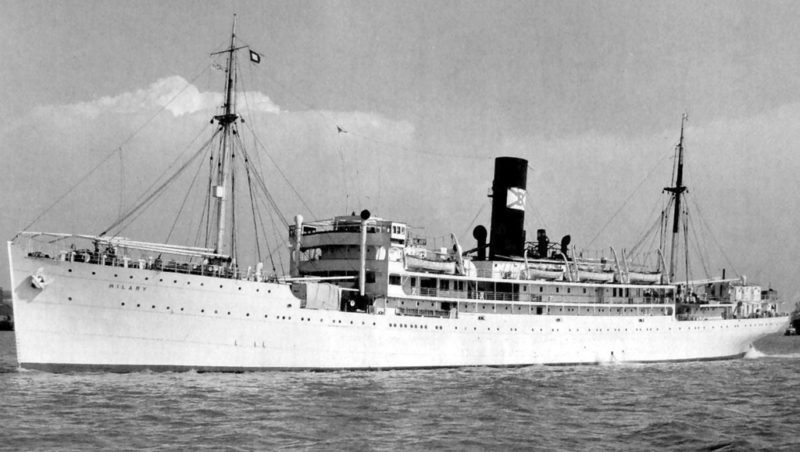
THE PORT OF MANAUS IN THE MODERN ERA
Booth Line passenger services to Brazil ceased in 1964 when Hubert of 8,062 grt, completed by the Birkenhead yard of Cammell, Laird & Co. Ltd. in 1955, was transferred to Blue Star Line and bareboat chartered to Austasia Line for service in the Far East. The larger Anselm of 10,854 grt with accommodation for 135 First Class and 101 in Tourist Class had served in the Booth Line fleet from 1961 to 1963, when she was also transferred to Blue Star Line as Iberia Star for the London to Brazil and the Plate trade, and then in 1965 on to Austasia Line for service in the Far East. She had been built in 1950 as Baudouinville by the Cockerill yard on Belgium for Compagnie Maritime Belge (CMB). Booth Line joined the Vestey Group in 1946, with Booth Line and Lamport & Holt retaining their own ships, staffs and offices, and Blue Star Line ships from 1955 were occasionally seen on the Amazon river in response to Booth Line ships calling at big South Atlantic ports such as Rio de Janeiro, as both of these great British shipping lines trading to Brazil then worked in conjunction.
The Booth Line cargo service from New York to the Amazon was terminated in 1977 as competition from South American shipping companies had increased and the amount of cargo on offer had diminished, thus bringing to an end a service spanning almost a century. Booth Line then carried on the Amazon trade with a variety of small cargo ships until 1986, and used only chartered ships after that date. The end of the trade came in 1992 from Liverpool when the last two chartered ships were withdrawn from service, ending a 126 year link with the Amazon.

The Port of Manaus today has a large fishing fleet based on the Malcher floating platform. The current industries of Manaus include cattle abattoirs with animals from the savannas of the upper river and the export of their hides and leather, an oil refinery with crude oil arriving by river in barges from Peru, a steel works, brewing, shipbuilding and the production of electrical, electronic equipment, computers, laptops and mobile telephones, motorcycles, chemicals, soap, Brazil nuts, wild fruits, cacao beans, pelts, resins, barks, woven hammocks, live animals, lumber and associated forestry products. The sharp and sturdy scales of a large river fish are also exported for use as nail files. A good part of the electrical energy consumption of the current industries of Manaus could be replaced by renewable energy in the form of solar panels and wind turbines.
Deforestation of the Amazonian and Brazilian forests continues at an alarming rate today, with the gain of timber, minerals and agricultural products for export, but the loss of precious rain forest that creates oxygen from the abundant carbon dioxide in the atmosphere, and thus creates the inexorable rise in global climate temperatures, running at a very high level of surface temperature increase of 1.05 degrees Centigrade. Nineteen of the warmest years on the planet have occurred since the Millennium, with the exception of the year 1998.
The Port of Manaus is located at position 3°08′ South, 60°01′ West, with the Port Head Office at Rua Marques de Santa Cruz in the centre of Manaus, and it is officially described as a river port with a medium cargo tonnage throughput. The Port is governed by the Autoridada Portuaria or the Porto Publico de Manaus, with the Head Office containing the Port Operations Room, the Billing Room, Federal Police Station, Ministry of Health, Ministry of Agriculture, Dispatch Department, and the OGMO Trades Union office.
The overall length of the Paredao floating platform is 289.5 metres with two outside berths for deep sea cargo ships and cruise ships and two inner berths. The overall length of the Malcher floating platform is 293.0 metres with a use by deep sea ships only possible during periods of river flood when the river has its greatest depth of water. There are ten warehouses in the port of a total enclosed area of 17,518m2, with the container yard having an area of 21,406 square metres, and two other open areas for storage of cargo of 35,510 square metres. There is a potable water supply, and provisions, fuel oil, diesel oil, garbage disposal and dirty ballast removal are all available, with ship repairs of a minor to moderate nature undertaken. There are fixed, mobile and floating cranes and lifts all the way up from 20 tonnes to 100 tonnes, with the floating crane always moored on the inside berth of the Paredao platform. The electrical power network of the port runs at 380 volts. The land area of the port is 77,660 square metres, the river area of the port is 16,763m2, to give a total land and water area of the port of 94,423m2. The river anchorage is 76 feet deep outside of flood season, the access channel depth is 13.5 metres, the alongside depth of the Paredao floating platform is 35.0 metres in flood, and 18.0 metres at ebb. The alongside depth of the Oil Terminal is 35 feet, with compulsory pilotage and quarantine procedures. Four ship’s agencies operate in Manaus port and city.
The number of visiting cruise ships at the port in a normal year is around fifteen cruise ships, drawn from the worldwide fleet of Seabourn, Oceania, P&O, Princess Cruises, Hapag Lloyd, Holland America Line, Viking, Cunard and Regent, as well as expedition type cruise ships on ‘discovery’ river cruises. The ever popular river tours are operated from the Malcher floating platform, and visit the Paricatuba Waterfall on the Rio Negro river that was formed by sedimentary rocks amongst the rain forest, the ‘Love Cascade’ with cool, clear water for bathing but can only reached by hiking after leaving the river tour boat, and many very fine sandy beaches along the river.
The city has botanical and zoological gardens that will fulfil the wishes of every visiting botanist and animal lover. The Iberostar Gran Amazon is a luxury tour boat that can carry up to one hundred passengers in comfort on cruises up and down the river from Manaus with stops at several places where passengers can enjoy the rain forest. Eco hotels can be found throughout the Manaus region, the Tropical Manaus Eco Resort has 588 luxury apartments and is only ten kilometres from the airport and sixteen kilometres from downtown Manaus. Manaus city has ten large green areas of vast acreage, included a 230 hectare refuge created in 1982 to protect a population of endangered pied tamarins. The Amazonian forests have more than one third of all the different species wildlife in the world living here.
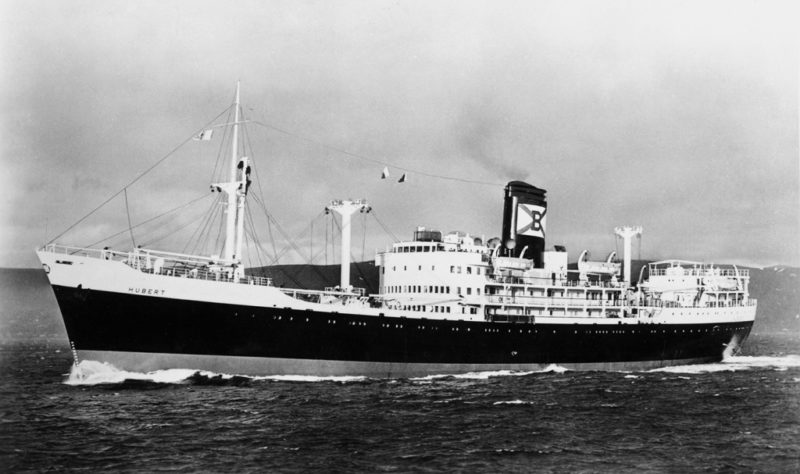
A Free Trade Zone of 10,360m2 was set up in 2005 with tax incentives to encourage the development of new businesses that could generate new business for the port. The current boom in business at Manaus far outstrips and exceeds the colonial rubber boom of the 19th century. The Manaus International Airport is situated only ten miles north of the port and is named after the Brazilian political and military figure of Air Marshal Eduardo Gomes. The population of the city of Manaus is growing at a very fast rate from 1.158 million in 1996, to 1.802 million in 2010, and to the current 2020 population of 2.223 million, making it the seventh largest city in Brazil.
The Manaus-Iranduba road bridge spans the Rio Negro river just upstream of Manaus City. This bridge has a central suspension span with separate ‘up’ and ‘down’ channels beneath. There are no bridges at all across the wide Amazon river, not because the width is too great for bridge spans, but because there are very few or no connecting roads for the route of a bridge to be considered. Passengers and local freight cross the river at many points in ferry boats, water taxis and river passenger and cargo vessels. Deep sea bulkers bring in grain up to Panamax size of 70,000 dwt at Manaus, while smaller dry cargo vessels of up to 9,000 dwt trade to Iquitos in the upper river. Tankers up to Medium Range (MR) size of 60,000 dwt, and container ships of up 4,500 TEU capacity also arrive at and trade on the Amazon up to Manaus. The Oil Tanker Terminal and the berth for Panamax bulk carriers are downstream of the main Base Area of the port, which has the Paredao and Walcher floating platforms.
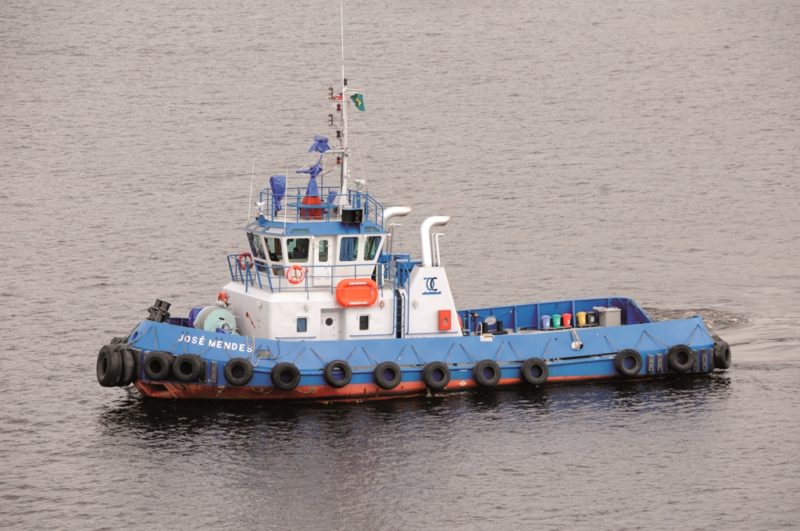
AMAZON CABOTAGE TRADE
The Amazon Steamship Navigation Co. Ltd. was set up in London on 6th May 1874 for regular passenger and cargo steamers running from Belem on the mouth of the Amazon to Manaus and Iquitos with thirty stopping points at towns, villages and small settlements at the side of the river. There was also a coastal trade to Caribbean ports as far north as Bridgetown on Barbados, Castries on St. Lucia and Fort de France on Martinique. Two designs were favoured from British shipbuilders such as Laird Brothers at Birkenhead, the first was for a three deck passenger and cargo vessel with two awning decks of 951 grt on dimensions of overall length 224.0 feet, moulded beam of 45.0 feet, and moulded depth of 10.8 feet with a loaded draft of 5.0 feet. One hundred cabin passengers, and one hundred deck passengers were carried on the upper awning decks, with ‘midships steam engines giving a service speed of 13 knots and smoke billowing from a tall, spindly funnel. The second favoured design was for a smaller two deck passenger and cargo vessel of 160 grt to carry 200 tons of cargo on dimensions of overall length 115.0 feet, moulded beam of 26.0 feet, and loaded draft of 3.3 feet. Two dozen First Class and fifty Third Class passengers were carried, with ‘midships steam engines and a tall, spindly funnel.
The twin funnelled steamer Justo Chermont was built by Laird Brothers in 1900 to the first design and was deleted from the register in 1931, but a replica passenger ship was built in 2001 for the film ‘A Selva’ (To the Forest) directed by Leonel Vieira of Portugal, and is on display at Manaus today. She has a black hull with a white line on her rubbing strake, and a white funnel with a central black band. Sisters of Justo Chermont included Campos Salles from Laird Brothers, and Belem, Bello Horizonte, Cuyaba, Districto Federal, Fortaleza and Sao Salvador from Jonker & Sons at Ido Ambacht with twin triple expansion steam reciprocating engines from the Alblasserdam Machinery Fabricators.
The Amazon Steamship Navigation Co. Ltd. had a fleet of 20 ships in 1888, 28 ships in 1893, and 32 ships in 1904, with 22 twin screw steamers, 4 of single screw, 4 paddle steamers and 2 stern wheelers. The company was financially reconstructed in 1911 as the Amazon River Steam Navigation Co. Ltd. (1911). A larger fleet was then operated that by 1926 had reached 46 steamers, 3 tugs, 3 barges for the transport of oil, and ten barges for the transport of coal, to give a fleet with a total net tonnage of 14,400. Subsidies were granted by the Brazilian Government to the Head Office in Para (Belem), with an office in Rio de Janeiro and another in Manaus. The title of the company was changed again in 1936 to the Companhia de Navegacao do Amazonas (CNA), with several motor passenger and cargo vessels built in post-war years.
However, the fleet had shrunk to only 5 vessels in 1974 but continued to operate into the Millennium with the tanker Liliana of 2,500 dwt and built in 1970. Today, the CNA river fleet based at Manaus comprises a fleet of large double hull oil barges of up to 5,000m3 capacity powered by pusher tugs of up 2,200 bhp, and also a small fleet of dry cargo ships of between 300 dwt and 2,000 dwt. Crude oil, oil products and derivatives, and biofuels are carried, and the vessels are equipped with satnav communications and oil spill recovery equipment.
Empresa de Navegacao da Amazonia S.A. (ENASA) has a shorter history of navigation on the Amazon, starting with operating 5 motor passenger and cargo ships of up to 1,350 grt and built during 1954 and 1964 in post-war years. It currently operates the three deck sister Amazon passenger ships Roraima and Rondonia of 2,657 grt and built in 1981 with the operating company ‘ENART’ emblazoned on their white superstructures. Three deck other passenger vessels such as Comte Paiva V operate regular ferry services along the full length of the river up to Manaus and Iquitos, calling at many cities, towns and villages on the way such as Macapa, Santana, Porto Velho, Itacoatiara, Obidos, Santarem, Parintins and many other stopping points, with a big total of 46 stops for passengers to alight at the side of the river. The road from Belem to Manaus is over 1,800 miles in length and impracticable during the rainy season, thus everyone goes everywhere by river passenger ships.
Alianca Navegacao e Logistica Ltda. operate 8 container ships of up to 3,820 TEU capacity and completed during 2013/14 under the Brazilian flag for service between Manaus on the Amazon and Brazilian South Atlantic ports to European and American ports. They are named after Portuguese, Spanish, Italian and Venetian early explorers e.g. Amerigo Vespuccio (1454-1512), Bartolomeu Dias (1450-1500), Fernao de Magalhaes (1480-1521), Pedro Alvares Cabral (1467-1520), Sebastiao Caboto (1474-1557) and Vicente Pinzon (1462-1514), as well as Alianca Manaus and Alianca Santos. All of this octet have service speeds of 20 knots with dimensions of overall length 234 metres by moulded beam of 37 metres, and operate under the umbrella of the Hamburg Süd Group of Germany, which was taken over on 1st December 2017 by Mærsk Line. The company was founded by Carl Fischer of Germany in 1950 using one ship transporting fruit between Brazil and Argentina. By 1959, the company had captured 50% of the market transporting refrigerated meat between Brazil and Argentina under the Brazilian flag. In 1967, Alianca began operating internationally to Europe and from 1991 the service expanded to the American market. A fleet of a dozen ships was owned in 1994, and four years later Alianca was acquired by the Oetker Group and Hamburg Süd. The Manaus office of Alianca is near the port at Colonia Oliveira Machado.
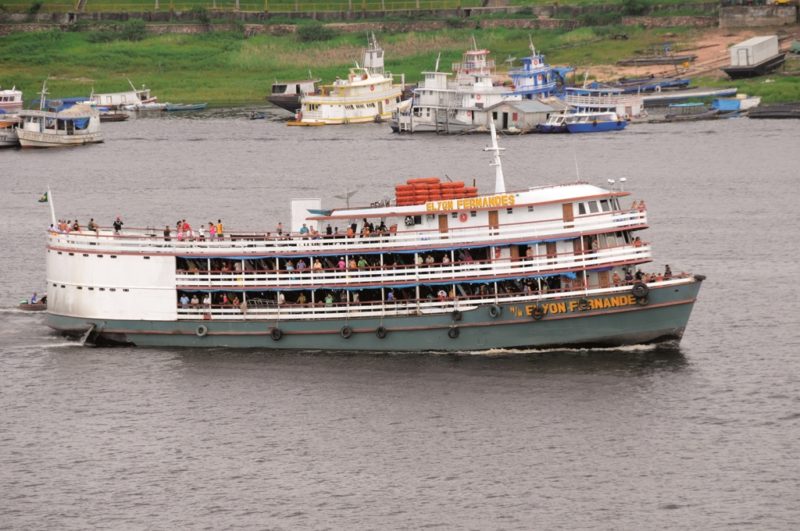
Libra Line (Brazil) specialising in South Atlantic and Amazon trades with over fifty years of experience in addition to a fleet of approximately thirty ships, a large network of agencies in Brazil, and with over 600 employees it operates mostly with chartered tonnage from international container groups trading to and from the Caribbean and beyond. The Libra Group also operates internationally in the Hapag Lloyd Group with a mixed fleet of over 80 bulkers, container ships, product and chemical tankers, and other types of ship, and successfully reinvests its profits in the shipping industry.
Wilson, Sons & Co. Ltd. were founded in 1837 in Salvador by the brothers Edward Wilson and Fleetwood Pellew Wilson from London. Salvador is the oldest city in Brazil and was founded only sixty years after Colon had discovered the New World in 1492, and has magnificent buildings of Portuguese architecture dating from that period. The brothers supplied coal from England and North America at first and became the agents for British ships in many Brazilian ports including Recife (1850), Rio de Janeiro (1862), Sao Paulo (1888), Santos (1888) and Manaus (1900). They have 180 years of experience on the Brazilian coast and in the maritime world. They built the first dry dock in Brazil on Ilha de Mocanque Pequeno island in 1869, and began their towage business in 1936. The company was nationalised by the Brazilian Government in 1971 with a Head Office in Rio de Janeiro. They acquired their first shipyard at Estaleiro Guaruja in 1973, opened the Niteroi yard in 1975, the Santo Andre port in 1998 and the Rio Grande shipyard in 2010. They currently also own two Brazilian container terminals at Salvador (Tecon Salvador) and Rio Grande do Sul (Tecon Rio Grande), a big fleet of 80 tugs and 23 offshore support vessels operating from two offshore bases strategically based for the Santos and Campos oilfields.
Posidonia Shipping & Trading S.A. are focused on coastal cabotage, international shipping, and offshore operations, operating an owned fleet of vessels and chartered ships. The fields of operation are cabotage container feeder transportation, dry cargo, asphalt tankers, auto transportation, offshore maritime support and ship management. The Capesize ore carrier Aquarange was long term chartered in March 2020 to carry cargoes of 160,000 tonnes of iron ore between the ports of Ponta da Madeira and Tubarao on the Brazilian South Atlantic coastline.
Mercosul Line was established in 1996 as a Brazilian cabotage shipping company offering ‘door to door’ services, and was acquired by Maersk Line in 2006 when it employed 160 seafarers and 92 shore staff with a turnover of $128 million. Mercosul was acquired by CMA CGM from Mærsk Line on 8th December 2017 as a leading player in the domestic Brazilian shipping market. It currently serves a dozen Brazilian ports with a fleet of four larger container ships of 2,500 TEU capacity as well as smaller feeder container ships. Mercosul Santos of 2,478 TEU capacity was sailing upriver to Manaus and unfortunately collided at 0400 hours on 2nd August 2017 with a tug pushing barges down the Amazon river with nine workers reported missing and drowned. A head on collision left one of the barges impaled on the bulbous bow of the container ship, and another barge was cut in half and quickly sank to the bottom of the river in 35 metres of water. A total of 11 crew were onboard the tug and barges, with firemen and divers sent from the city of Santarem to look for the missing crew.
Transportes Bertolini Ltda. and J. F. de Oliveira Navegacao Ltda. both operate large fleets of pusher tugs pushing soya bean laden long barge strings from Manaus down the Amazon to Belem at the mouth of the estuary and Brazilian South Atlantic ports. The tugs are either single screw or twin screw pusher tugs with powerful M.A.N.-B&W diesel engines with controllable pitch propellers and Alphatronic control systems, and were completed by the Estaleiro Sao Joao yard in Brazil. The barge strings are very wide and long and are similar to the lumber strings towed around British Columbian ports.
BR DO MAR CABOTAGE PROJECT BILL
A cabotage bill known as ‘BR do MAR’ was sent to the Brazilian Congress on 11th August 2020 as a matter of urgency and a means of boosting cabotage coastal trade by 30% per year, encourage competition, create new shipping routes and reduce transport costs. The volume of containers shipped coastwise will have increased from 1.2 million TEU in 2019 to 2.0 million TEU in 2022. The coastal cabotage fleet will have increased by 40% by 2022, as container cabotage cargo has grown by over 10% per annum in all of the years from 2016. The method of executing this bill is fourfold:-
· To encourage Brazilian shipping companies to have more control and greater security over their shipping fleets, and also when one of their own fleet is undergoing repairs or maintenance a foreign flag vessel can be chartered in time to lower operating costs.
· Shipbuilding capacity to be expanded to reduce the ordering of vessels from yards in China and the Far East. There are 47 shipyards in Brazil with eleven new yards under construction, and a total workforce of 59,000 building merchant and naval vessels, and eighteen offshore oil platforms. These yards include Estaleiro Bibi established on 7th May 2002 and based in Manaus with a workforce of 11,987 workers currently building a river hospital ship for the Brazilian Navy, joining a fleet of five other river hospital ships in service for the treatment of people living in remote river areas. There are also seven State owned yards for the repair and construction of warships at the seven naval bases throughout the country, and merchant shipbuilding yards such as Atlantico Sul at Suape in Ipojuca, and the Inace yard at Fortaleza.
· Costs of bureaucracy will be reduced on various aspects of operation, with the projected increase in cabotage coastal trade to further reduce costs.
· A port modernisation agenda is already being used by the Brazilian Government with fourteen port areas in five areas already leased in 2019. A total of 47 port areas and port terminals are listed for authorisation as areas for the movement of cargo by Brazilian shipping companies that do not as yet have operations at these ports. New investment in Brazilian ports will be sped up to ensure that ports are prepared for the future increased demand from coastal cabotage operations.
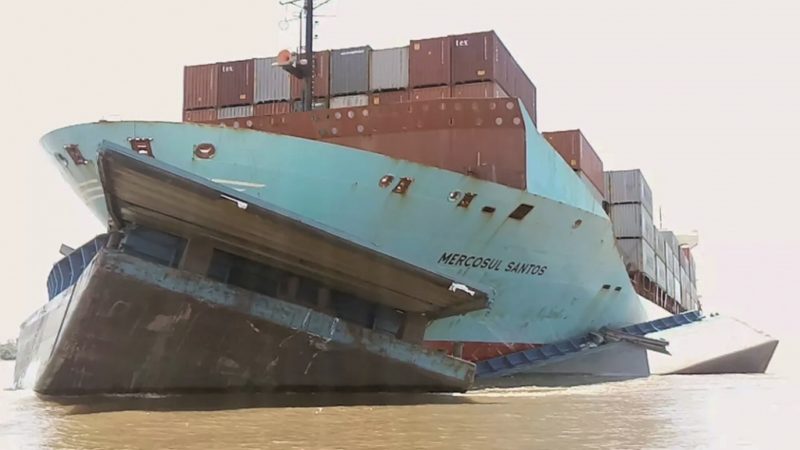
POSTSCRIPT
The Amazon is a mighty river with the peak levels of the seasonal river floods reached in April and May near the mouth of the Xingu river around 250 kilometres from the estuary mouth. The Amazon river system is very complex with no simple answer to the annual flood depth of water, with peaks in river level in May near Iquitos in Peru, and the final massive flood at Manaus in June and July, about two months after the highest rainfall months due to a flooding anomaly known as the backwater effect caused by seasonal differences in the arrival times of floods from the northern and southern tributaries. Manaus has to be prepared for three months of annual flood for possible disruption due to ships damaging the two main floating terminals at the Base Area of the port. There are many small river passenger ferries also berthed at other points in the port, and all have to be prepared to cast off and steam around in the middle of the flood for safety reasons.

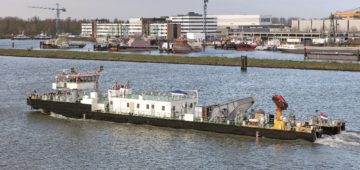



Comments
Sorry, comments are closed for this item